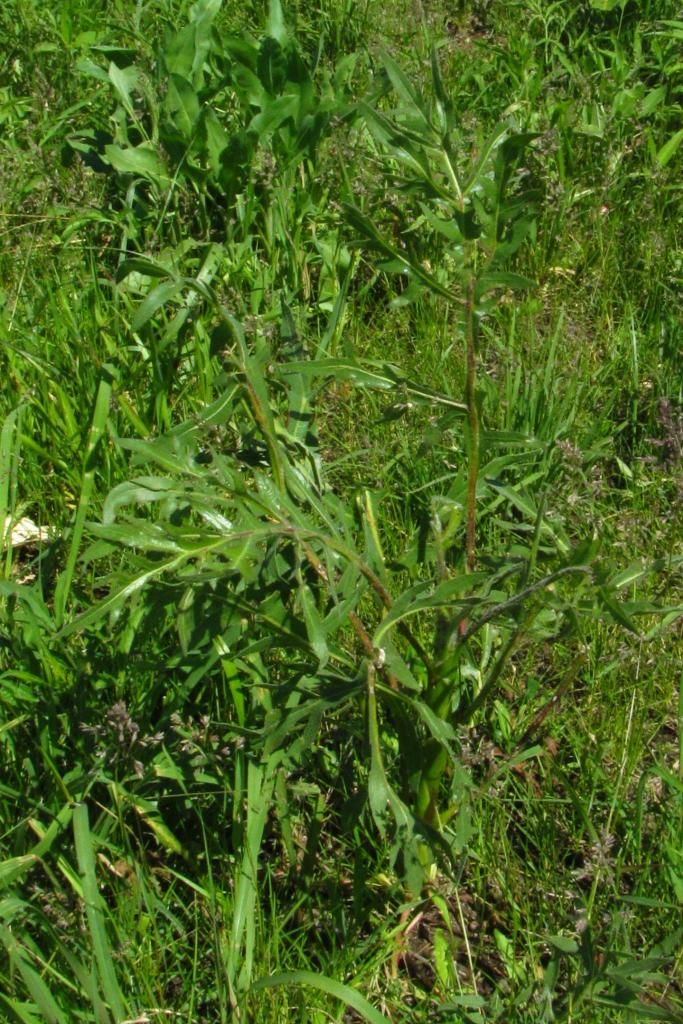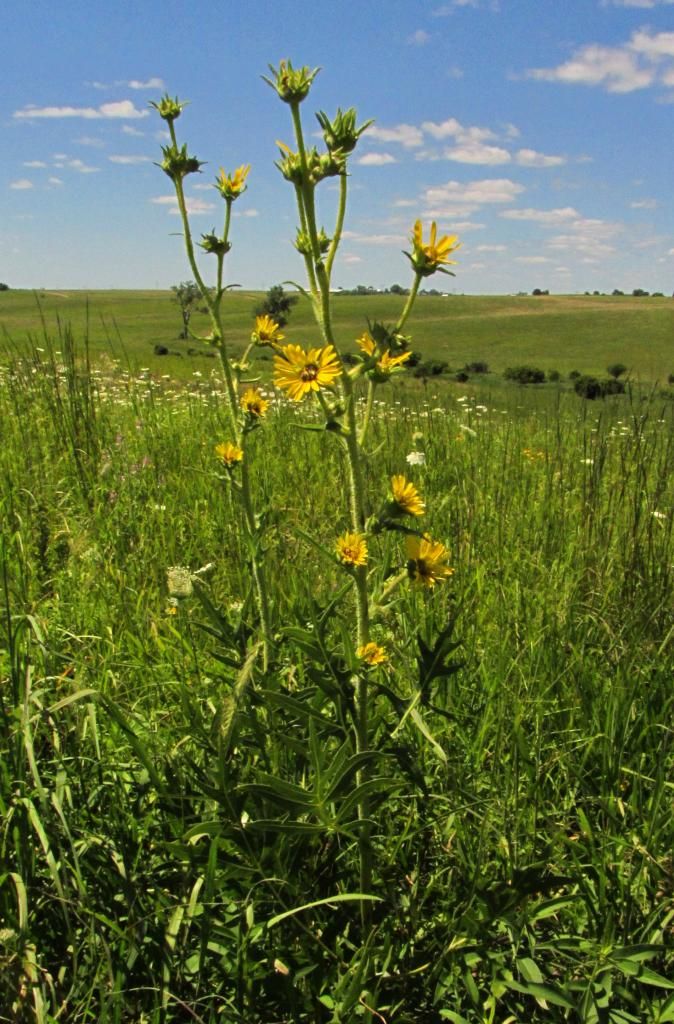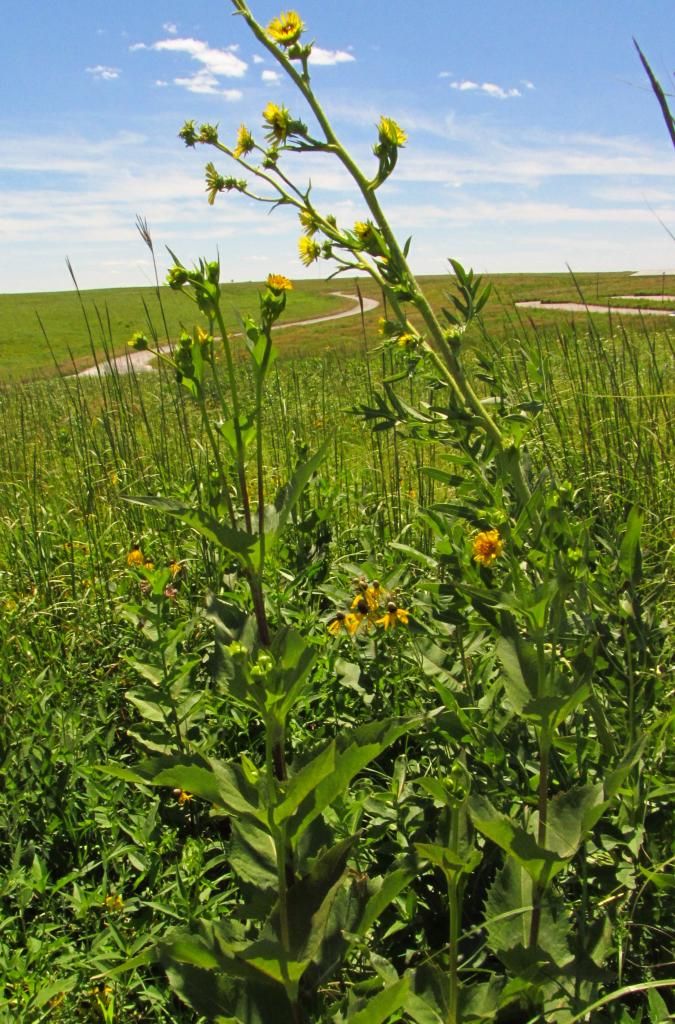This week’s featured Iowa native is one of the tallest of the tallgrass prairie plants. Like ox-eye, sawtooth sunflower, common sunflower, and its close relative cup plant, compass plant (Silphium laciniatum) is a member of the aster family with yellow flower heads. Its great height makes it easy to distinguish from the other yellow asters. Generations of people have used the plant to help find their way. Several photos of compass plant are after the jump.
This is an open thread: all topics welcome. Happy new year to the members of the Bleeding Heartland community who celebrate Rosh Hashanah.
The U.S. Department of Agriculture’s Natural Resources Conservation Service describes compass plant as follows (pdf):
Compass plant is a long lived, perennial member of the sunflower family. Its basal leaves and stems all arise from an underground crown. A large reddish brown tap root 1 to 2 inches in diameter is located just below the crown. The tap root rapidly looses diameter as it descends up to 16 feet into the prairie soil. The large basal leaves can be 15 to 24 inches long and are deeply cut like a giant pin oak leaf. The rigid, sand paper like leaves orient themselves in a north to south direction to avoid the direct rays of the midday sun, thus leading to the plants common name, compass plant. Stems are erect and number from one to several with an overall height of from 3 to 10 feet. The simple leaves are alternately arranged on the stem and are less divided, smaller and have direct attachment higher up on the stem. Leaves are leathery and stiff with rough surfaces and hairs occurring on the leaf main veins. Large yellow flower heads from 2 to 4 inches across are conspicuous on the upper half to two thirds of the stem in small clusters. Flowering begins in late June and proceeds through August. Flower heads begin opening at the top of the stem first. There are 15 to 34 narrow yellow petal flowers (ray florets) that are 1 to 2 inches long. The center of the flower contains the numerous disk florets with yellow corollas.
Those basal leaves emerge in the late spring and are visible well before the stalk grows tall and starts blooming. I took this picture of a compass plant seedling at the Neal Smith National Wildlife Refuge in early June. It’s hard to make out against the greenery in the background, but the compass plant leaves have deeply cut lobes.
The Iowa Department of Transportation has seeded compass plant along many roadsides, and I saw lots of these plants in bloom near I-80 in eastern Iowa this summer. This plant was growing at the Neal Smith restored prairie in late July.
This picture came from a restored prairie in Dallas County last month. Although the compass plants in the middle distance are out of focus, you can see how they stand out on the landscape. In the foreground, that’s yellow or gray-headed coneflower on the left. The dark pink flowering plant on the right is ironweed. I think that the lighter pink flowers in between are some kind of tick trefoil, possibly Illinois tick trefoil or showy tick trefoil.
As tall as compass plants are above ground, the roots grow several feet deeper below ground, making the plant highly drought-tolerant.
You can also get a sense of the compass plant’s height in this photo from Neal Smith. Those are cup plants in the foreground, and gray-headed coneflowers behind them.
According to Wildflowers of the Tallgrass Prairie by Sylvan Runkel and Dean Roosa,
When in bloom, the compass plant forms a gummy material along the upper third of the main stem. This resinous material (hence, the name rosinweed) was used by American Indians as chewing gum. Pioneer children on their way to and from country school also took advantage of this free prairie chewing gum.
Compass plant had several traditional medicinal uses and helps many animals thrive in prairie habitats.
It is reported that compass plant is palatable and nutritious and grazed by livestock especially in its juvenile state. It will decrease in heavily grazed pastures and eventually be removed from the site in continuously grazed situations. […]
Wildlife: Small mammals and birds eat the seed of compass plant. In grasslands the compass plant provides a sturdy perch for prairie song birds. The eastern kingbirds use the compass plant as a perch to locate and capture grassland insects.





1 Comment
Compassplant is my husband's favorite prairie flower...
…and these photos are fun to see, thank you! I think those pink flowers are more likely showy tick-trefoil. Illinois tick-trefoil tends to be paler and the flowers are spaced further apart on the stems.
PrairieFan Wed 26 Apr 5:06 PM